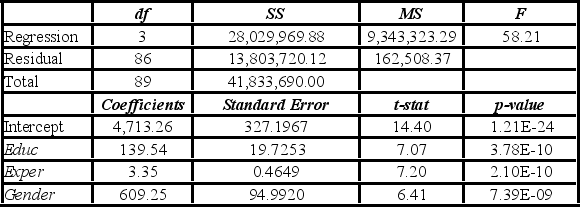Multiple Choice
To examine the differences between salaries of male and female middle managers of a large bank, 90 individuals were randomly selected, and two models were created with the following variables considered: Salary = the monthly salary (excluding fringe benefits and bonuses) ,
Educ = the number of years of education,
Exper = the number of months of experience,
Train = the number of weeks of training,
Gender = the gender of an individual; 1 for males, and 0 for females.
The Excel partial outputs corresponding to these models are available and shown below.
Model A: Salary = β0 + β1Educ + β2Exper + β3Train + β4Gender + ε  Model B: Salary = β0 + β1Educ + β2Exper + β3Gender + ε
Model B: Salary = β0 + β1Educ + β2Exper + β3Gender + ε  A group of female managers considers a discrimination lawsuit if on average their salaries could be statistically proven to be lower by more than $500 than the salaries of their male peers with the same level of education and experience. Using Model B, what is the conclusion of the appropriate test at 10% significance level?
A group of female managers considers a discrimination lawsuit if on average their salaries could be statistically proven to be lower by more than $500 than the salaries of their male peers with the same level of education and experience. Using Model B, what is the conclusion of the appropriate test at 10% significance level?
A) Do not reject H0; the salaries of female managers cannot be proven to be lower on average by more than $500.
B) Reject H0; the salaries of female managers cannot be proven to be lower on average by more than $500.
C) Do not reject H0; the salaries of female managers are lower on average by more than $500.
D) Reject H0; the salaries of female managers are lower on average by more than $500.
Correct Answer:

Verified
Correct Answer:
Verified
Q72: Consider the following regression model: Humidity =
Q73: A bank manager is interested in assigning
Q74: If the number of dummy variables representing
Q75: To examine the differences between salaries of
Q76: For the model y = β<sub>0 </sub>+
Q78: A model y = β<sub>0</sub> + β<sub>1</sub>x
Q79: Regression models that use a dummy variable
Q80: A medical researcher is interested in assessing
Q81: In the regression equation <img src="https://d2lvgg3v3hfg70.cloudfront.net/TB6618/.jpg" alt="In
Q82: Consider the model y = β<sub>0 </sub>+